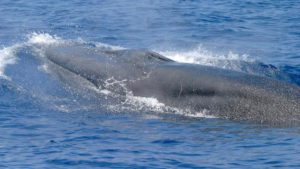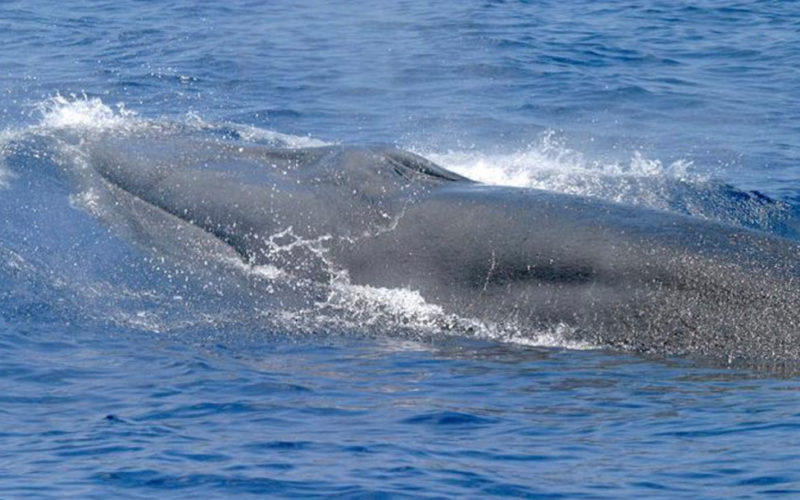
Environmental groups want the federal government to set speed limits for large ships in the Gulf of Mexico south of Florida’s panhandle to help protect an endangered whale species.
The National Resources Defense Council (NRDC) in May filed a petition with the National Oceanic and Atmospheric Administration (NOAA) requesting speeds no higher than 10 knots across an 12,000-square-mile area. The rules, which would be in place year-round for vessels 65 feet and longer, are intended to protect the Rice’s whale.
“What we’ve called for here is essential to the recovery of the species,” said Michael Jasny, director of marine mammal protection for the NRDC. “We’re looking at a species that doesn’t have a lot of time, and we’re hoping the agency will act expeditiously on the plan we’ve submitted.”
Healthy Gulf, Defenders of Wildlife and the Center for Biological Diversity are among the groups supporting the petition. It argues NOAA Fisheries is obligated under the Endangered Species Act to protect the Rice’s whale, of which only about 50 remain.
NOAA Fisheries established some restrictions last year for oil and gas industry vessels operating in the core habitat areas for the Rice’s whale south of Florida and Alabama, the NRDC said. The petition asks for similar rules to be expanded to other vessel classes across a wider area.
The Rice’s whale is named for American biologist Dale Rice, who was the first scientist to discover this whale species in the Gulf of Mexico. They can grow to 42 feet long and weigh up to 60,000 pounds. A section of the Gulf known as Desoto Canyon is a core habitat for these whale.
Research following the Deepwater Horizon disaster in 2010 led to the whale’s discovery. Scientists trying to assess exposure to the spill took tissue samples from the whales. These samples helped prove the Rice’s whale was a unique species, distinct from other baleen whales. The new species was protected under the Endangered Species Act in 2019 and formally recognized as a distinct species in 2021.
Following that determination, Rice’s whales immediately became one of the most endangered whale species anywhere in the world. “Roughly 50 of the whales are left in existence and many are concentrated in this one submarine canyon that leaves them vulnerable to activity taking place there,” Jasny said.
The NRDC arrived at the 10-knot speed based on research done on ship-strike prevention efforts concerning the North Atlantic right whale. A speed limit was imposed in 2008 in its habitat along sections of the East Coast of the United States. A federal analysis found that compliance was high, with approximately 85 percent of vessels keeping speeds below 10 knots in the designated area.
“If you reduce the speed of a vessel to 10 knots or below, you significantly reduce the likelihood of a strike, and if the whale is hit, you’re reducing the lethality risk,” Jasny said.
He added that a vessel moving a lower speed will have improved fuel efficiency, lower greenhouse-gas emissions and lower levels of undersea noise.
The proposal within the Gulf would primarily apply to commercial vessels, although Jasny acknowledged that it would apply to some recreational vessels as well. Enforcement would be conducted via AIS by federal authorities such as the Coast Guard and NOAA.
Shipping interests and Gulf of Mexico energy exploration groups declined to comment on the proposal. NOAA is currently reviewing the petition.
Jasny said the NRDC has not received significant feedback from industry groups since filing the petition.
The Rice’s whale, also known as the Gulf of Mexico whale, lives in relatively shallow water for marine mammals. It spends much of its time feeding or resting just below the water’s surface within the draft of commercial vessels and is often resting at night. These factors make the whales susceptible to being hit by passing ships.
As such, the NRDC petition asks that commercial vessels not transit through the whales’ habitat at night. It also asks that vessels stay at least 500 meters away from any Rice’s whales they see while underway in areas subject to the proposed restrictions.
These proposals are not merely academic in their origins. In recent years, at least one Rice’s whale has died, and another suffered injury consistent with blunt trauma from a vessel collision.
With so few of the species left, the NRDC is hoping NOAA will move fast to enact the restrictions. “It’s evident,” Jasny said, “that strikes represent a significant threat to the species’ survival.”

